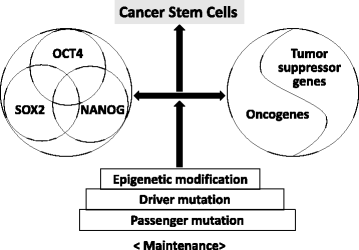Cancer cell reprogramming to identify the genes competent for generating liver cancer stem cells
- PMID: 29259714
- PMCID: PMC5725927
- DOI: 10.1186/s41232-017-0041-x
Cancer cell reprogramming to identify the genes competent for generating liver cancer stem cells
Abstract
The cancer stem cell (CSC) hypothesis postulates that cancer originates from the malignant transformation of stem/progenitor cells and is considered to apply to many cancers, including liver cancer. Identification that CSCs are responsible for drug resistance, metastasis, and secondary tumor appearance suggests that these populations are novel obligatory targets for the treatment of cancer. Here, we describe our new method for identifying potential CSC candidates. The reprogramming of cancer cells via induced pluripotent stem cell (iPSC) technology is a novel therapy for the treatment and for the study of CSC-related genes. This technology has advantages for studying the interactions between CSC-related genes and the cancer niche microenvironment. This technology may also provide a useful platform for studying the genes involved in the generation of CSCs before and after reprogramming, and for elucidating the mechanisms underlying cancer initiation and progression. The present review summarizes the current understanding of transcription factors involved in the generation of liver CSCs from liver cancer cell-derived iPSCs and how these contribute to oncogenesis, and discusses the modeling of liver cancer development.
Keywords: Induced pluripotent stem cells; Liver cancer; OCT4; Reprogramming; c-JUN oncogene.
Figures

References
Publication types
LinkOut - more resources
Full Text Sources
Other Literature Sources
Miscellaneous

